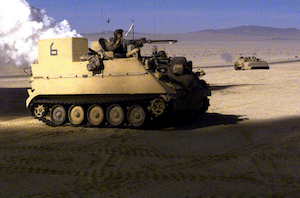The United States military designed a series of tests, MIL-STD-810G, to test its equipment limits in a variety of conditions under which it is to be used. In this post, we’ll take a closer look at MIL-STD-810G, including its purpose, how it works, and best practices for ensuring compliance.
Known as the Environmental Engineering Considerations and Laboratory Tests, MIL-STD-810 focuses on tailoring military equipment’s environmental design and test limits to the conditions it will undergo during its service life. These conditions range from different environments to transportation conditions such as shocks. The tests themselves also vary depending on the nature, size, and weight of the equipment being tested.
Over time, MIL-STD-810 has evolved and been updated. MIL-STD-810G is the latest revision and is a comprehensive document including several corrections, significant changes, and additions to MIL-STD-810F that include five new test methods. While MIL-STD-810 is specifically for military equipment and applications, the standard often is used for commercial products, too.
The military must have a formal method of testing equipment under various environmental conditions in order to keep service members safe and to prolong the service life of the equipment itself. They also need equipment designers, engineers, and manufacturers to understand exactly the type of environments and conditions military equipment must be able to withstand. 
As such, specifications and standards have been developed over the past 70 years that have evolved to become MIL-STD-810G. Over time, the standards have come to include more specific statements for shock and vibration tests that mimic real-world operating environments and that allow for the creation of test chambers to simulate conditions encountered during a product’s service life. For example, Test Method 527 of MIL-STD-810G calls for the use of multiple vibration exciters for performing multi-axis shaking to excite test article resonances and simulate real-world vibrations. This method combines three distinct tests on the x, y, and z axis into one.
There are 24 categories of laboratory test methods for MIL-STD-810G, which are then broken down further into procedures, specific tests, or levels, that are appropriate to the environment in which the equipment will be used. Each test is carried out using predefined test plans and criteria.
It is important to remember that tests may be laboratory or natural environment field tests or a combination of the two, and that test procedures depend on the environments tested. After each environmental test is completed, post-test data is examined and recorded in relation to material specifications and program guidelines. Analysis of test results is included in a final test report for each test.
The best way to meet MIL-STD-810G testing standards is to become familiar with them, the testing methods, and the final test reports of your equipment. Remember that just because something is designed to meet the standards does not mean that it was tested or compliant with MIL-STD-810. It is not until the actual tests are conducted that manufacturers will know whether their products are compliant in a specific operating environment.
The first step is to familiarize yourself with the environments in which your products will be used. For example, most military equipment will be subjected to outdoor exposure, extreme temperatures, chemicals, and cleaning processes. They may be subjected to sand, wind, rain, snow, UV, and saltwater, too. This means that each part of your product, including its nameplate and data plate, must be durable enough to withstand these environments and conditions and MIL-STD-810G test methods. Ensure your nameplates and data plates meet not just industry standards but also these tough military standards.
A material frequently used for nameplates and data plates, that has been tested and found to be durable enough to meet MIL-STD-810G standards, is photosensitive anodized aluminum or Metalphoto®. Metalphoto plates are exceedingly durable and are the preferred choice for the military industry because of their protective finishes and resistance to chemicals, abrasion, and solvents. In fact, Metalphoto nameplates and data plates feature high-resolution graphics that are sealed beneath an anodic layer that is sapphire-hard and impenetrable. These plates are designed specifically to withstand exterior exposure to the harshest environments including extreme cold, heat, and UV. With an expected exterior life of 20 years or more, Metalphoto® plates are the durable choice for equipment subjected to MIL-STD-810G test methods.
Image via Flickr by expertinfantry
Our sales engineers are experts in automatic asset tracking, tagging and identification,a nd can answer all your questions. Get in touch now.
Lets Talk ›